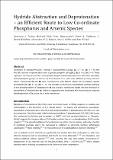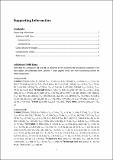Files in this item
Hydride abstraction and deprotonation – an efficient route to low co-ordinate phosphorus and arsenic species
Item metadata
| dc.contributor.author | Taylor, Laurence John | |
| dc.contributor.author | Buehl, Michael | |
| dc.contributor.author | Wawrzyniak, Piotr | |
| dc.contributor.author | Chalmers, Brian Alexander | |
| dc.contributor.author | Woollins, J Derek | |
| dc.contributor.author | Slawin, Alexandra Martha Zoya | |
| dc.contributor.author | Fuller, Amy | |
| dc.contributor.author | Kilian, Petr | |
| dc.date.accessioned | 2016-10-06T23:33:30Z | |
| dc.date.available | 2016-10-06T23:33:30Z | |
| dc.date.issued | 2015 | |
| dc.identifier | 218450493 | |
| dc.identifier | 0d418ca0-a79c-449b-8e8a-c278765486e6 | |
| dc.identifier | 84959020706 | |
| dc.identifier | 000371662000014 | |
| dc.identifier.citation | Taylor , L J , Buehl , M , Wawrzyniak , P , Chalmers , B A , Woollins , J D , Slawin , A M Z , Fuller , A & Kilian , P 2015 , ' Hydride abstraction and deprotonation – an efficient route to low co-ordinate phosphorus and arsenic species ' , European Journal of Inorganic Chemistry , vol. Early view . https://doi.org/10.1002/ejic.201500948 | en |
| dc.identifier.issn | 1434-1948 | |
| dc.identifier.other | ORCID: /0000-0002-1095-7143/work/48131756 | |
| dc.identifier.other | ORCID: /0000-0002-2999-2272/work/55901232 | |
| dc.identifier.other | ORCID: /0000-0002-9527-6418/work/56861825 | |
| dc.identifier.other | ORCID: /0000-0001-6379-3026/work/58285409 | |
| dc.identifier.other | ORCID: /0000-0002-1498-9652/work/31779171 | |
| dc.identifier.uri | https://hdl.handle.net/10023/9618 | |
| dc.description | This work was financially supported by the EPSRC and COST action grant CM1302 (SIPs). | en |
| dc.description.abstract | Treatment of Acenap(PiPr2)(EH2) (Acenap = acenaphthene-5,6-diyl; 1a, E = As; 1b, E = P) with Ph3C·BF4 resulted in hydride abstraction to give [Acenap(PiPr2)(EH)][BF4] (2a, E = As; 2b, E = P). These represent the first structurally characterised phosphino/arsino-phosphonium salts with secondary arsine/phosphine groups, as well as the first example of a Lewis base stabilised primary arsenium cation. Compounds 2a and 2b were deprotonated with NaH to afford low co-ordinate species Acenap(PiPr2)(E) (3a, E = As; 3b, E = P). This provides an alternative and practical synthetic pathway to the phosphanylidene-σ4-phosphorane 3b and provides mechanistic insight into the formation of arsanylidene-σ4-phosphorane 3a, indirectly supporting the hypothesis that the previously reported dehydrogenation of 1a occurs via an ionic mechanism. | |
| dc.format.extent | 1337124 | |
| dc.format.extent | 676026 | |
| dc.language.iso | eng | |
| dc.relation.ispartof | European Journal of Inorganic Chemistry | en |
| dc.subject | Phosphorus | en |
| dc.subject | Arsenic | en |
| dc.subject | Low co-ordinate | en |
| dc.subject | Peri-substitution | en |
| dc.subject | Base-stabilisation | en |
| dc.subject | QD Chemistry | en |
| dc.subject | DAS | en |
| dc.subject.lcc | QD | en |
| dc.title | Hydride abstraction and deprotonation – an efficient route to low co-ordinate phosphorus and arsenic species | en |
| dc.type | Journal article | en |
| dc.contributor.sponsor | EPSRC | en |
| dc.contributor.sponsor | EPSRC | en |
| dc.contributor.sponsor | EPSRC | en |
| dc.contributor.institution | University of St Andrews. School of Chemistry | en |
| dc.contributor.institution | University of St Andrews. EaSTCHEM | en |
| dc.contributor.institution | University of St Andrews. Office of the Principal | en |
| dc.identifier.doi | 10.1002/ejic.201500948 | |
| dc.description.status | Peer reviewed | en |
| dc.date.embargoedUntil | 2016-10-06 | |
| dc.identifier.url | http://onlinelibrary.wiley.com/doi/10.1002/ejic.201500948/suppinfo | en |
| dc.identifier.grantnumber | EP/E010695/1 | en |
| dc.identifier.grantnumber | EP/K031252/1 | en |
| dc.identifier.grantnumber | EP/K039210/1 | en |
This item appears in the following Collection(s)
Items in the St Andrews Research Repository are protected by copyright, with all rights reserved, unless otherwise indicated.


